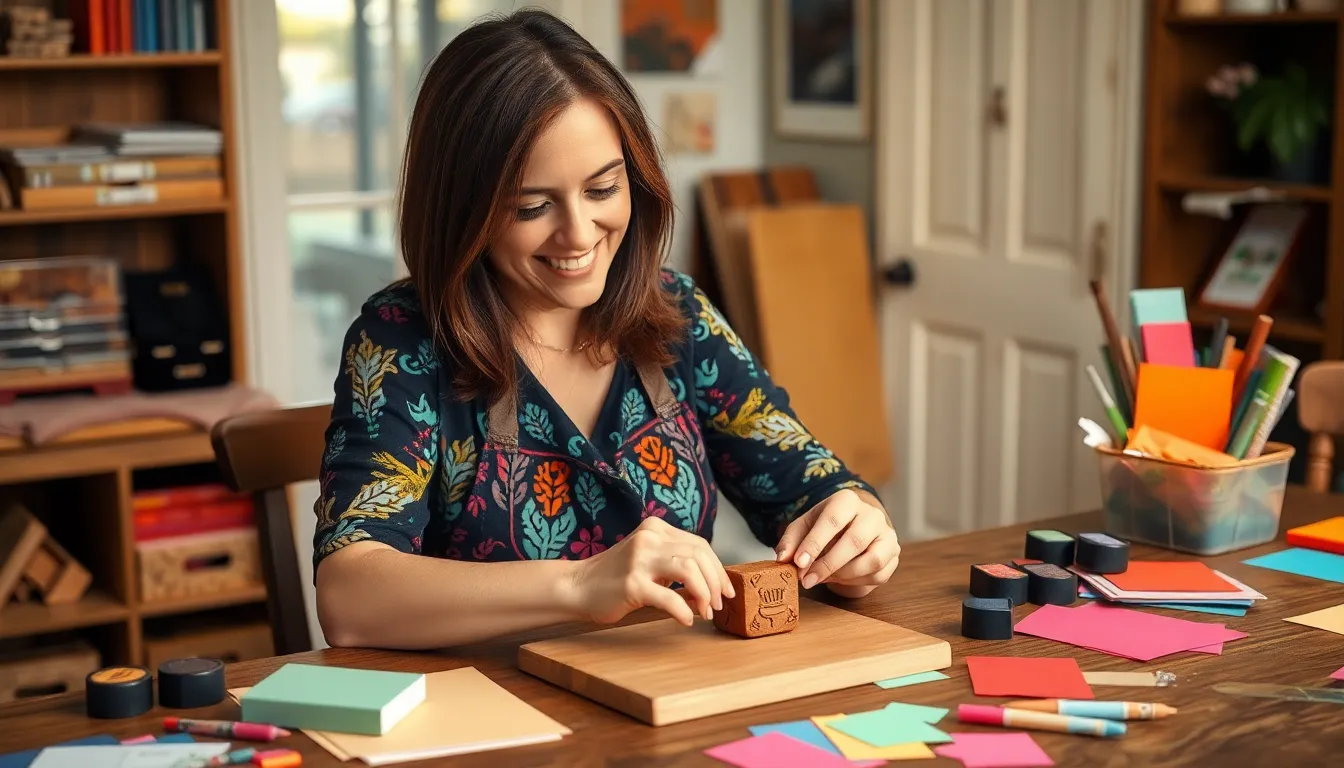Imagine transforming ordinary materials into fun, personalized stamps that bring creativity to life. Homemade stamps aren’t just for kids; they’re a crafty adult’s secret weapon against boring stationery. With a little imagination and some basic supplies, anyone can create unique designs that add flair to cards, gifts, or even scrapbooks.
Table of Contents
ToggleOverview of Homemade Stamps
Homemade stamps offer a creative outlet for individuals of all ages. Craft enthusiasts often utilize everyday items to produce unique designs. This approach fosters personalization in stationery, making correspondence more meaningful. Stamps enhance cards, gifts, and scrapbooks, adding a distinct touch that store-bought options cannot replicate.
Materials needed are typically accessible and inexpensive. Common supplies include rubber erasers, potatoes, or sponges, which serve as excellent stamp bases. Tools like carving knives or scissors allow for precise designs, enhancing the stamp’s detail. Ink pads in various colors add vibrancy to each impression.
Inspiration for designs can come from various sources. Nature, geometric patterns, or even simple shapes inspire many stamp creators. Online resources and social media platforms provide ample visual reference and tutorials, encouraging experimentation.
The crafting process engages both creativity and tactile skills. Creating a homemade stamp involves sketching a design, transferring it to the chosen material, and carving or shaping it. With practice, individuals can develop their unique styles and techniques.
Homemade stamps cater to specific themes or occasions. A holiday card, for instance, benefit from festive designs, while custom stamps resonate with personal expressions. They also serve as thoughtful gifts, offering a personal touch that enhances relationships.
Experimentation with different materials yields diverse results. Layering designs or combining colors can create intricate patterns. With each stamp, the potential to craft endless variations exists, encouraging continuous exploration and creativity.
Materials Needed for Homemade Stamps
Creating homemade stamps involves a few essential materials that are easy to find and cost-effective. The crafting process can be straightforward with these items on hand.
Common Supplies
Rubber erasers serve as an excellent base for many stamp designs. Potatoes offer a playful option for creating larger impressions, while sponges provide a softer texture for unique prints. Cardstock guarantees stability for intricate designs. Ink pads in various colors bring life to each stamped image, allowing for creative expression and personalization. Adhesives or double-sided tape keep stamps secure during use. Additionally, a cutting mat protects surfaces while crafting.
Specialty Tools
Carving knives enable precise detailing, perfect for intricate patterns. Craft scissors help cut out shapes with accuracy, essential for clean edges. A brayer facilitates even ink application across stamp surfaces, ensuring vibrant impressions. Linoleum cutters offer versatility for deeper carving needs. Importantly, stencils can assist in creating consistent shapes. Lastly, a ruler ensures measurements remain accurate when cutting out design components.
Techniques for Creating Homemade Stamps
Homemade stamps can be crafted using various techniques that enhance creativity and personalization.
Carving Stamps
Carving stamps involves using soft materials like rubber erasers or linoleum. First, individuals sketch their design on paper, then transfer it to the material. Next, carving knives or specific tools allow for detailed impressions. Precision is vital for achieving clean lines and shapes. After carving, applying ink from an ink pad ensures vibrant impressions on paper, making it ideal for cards or personalized stationery.
Using Everyday Objects
Everyday objects can serve as innovative stamps, transforming mundane items into creative tools. For instance, items like bottle caps, buttons, and sponges can create unique patterns. Individuals press these objects into ink and then onto paper, producing whimsical designs. Exploring the textures and shapes of these materials can yield surprising results, making crafting fun and versatile. Experimenting with various objects fosters an imaginative approach to stamp making.
Foam and Potato Stamps
Foam and potato stamps offer easy and effective methods for creating designs. Foam sheets can be cut into shapes and attached to a sturdy base for use with ink pads. Potatoes function as a natural stamp, allowing for simple carving into halves or quarters to create various shapes. The process is straightforward: apply ink and press onto paper. Both techniques are accessible, enabling creativity for all crafting levels.
Creative Ideas for Using Homemade Stamps
Homemade stamps provide a variety of opportunities for creative expression. Crafters can explore numerous projects tailored to their interests.
Craft Projects
Craft enthusiasts can enhance their projects using homemade stamps. Stamping on canvas bags transforms them into personalized totes. Handmade cards become more vibrant and original with unique stamp designs. Scrapbook pages gain character through repetitive patterns, adding depth to memories. Children enjoy stamping on paper to create art, fostering creativity. Decorative home items, such as pillows or tablecloths, benefit from stamps as well. Experimenting with different materials leads to endless possibilities, inspiring innovation.
Gift Wrapping and Stationery
Gift wrapping becomes more special and personal with unique stamped designs. Stamped paper adds a homemade touch to presents, making them stand out. Plain wrapping paper transforms into personalized masterpieces that recipients appreciate. Stationery also benefits significantly from custom stamps. Letterheads or note cards gain distinctiveness, reflecting individual styles. Hosting a gathering? Guests appreciate personalized place cards featuring stamps. The use of stamps elevates everyday stationery, making communication more heartfelt and memorable.
Maintenance and Care for Homemade Stamps
Proper maintenance ensures the longevity and effectiveness of homemade stamps. Clean stamps after each use to prevent ink build-up. Rinse rubber erasers or sponges under warm water to remove excess ink, using a soft brush for stubborn residue. Allow stamps to dry completely before storing them to prevent mold or damage.
Store stamps in a cool, dry place. Airtight containers work well for protecting them from dust and moisture. If using foam or potato stamps, ensure they’re kept in an upright position to maintain their shape. Regular inspections help identify any wear or damage that may affect stamping quality.
Repair can extend the life of stamps. Replace worn-out or damaged bases promptly to maintain clarity in designs. For foam stamps, glue can often patch minor damages. In instances of significant wear, redesigning the original pattern will reinvigorate the stamp’s lifespan.
Preservation of ink pads is crucial for successful stamping. Keep ink pads sealed when not in use to maintain moisture levels. Regularly reink pads before they dry out for consistent impressions. If an ink pad becomes overly saturated, blot it lightly with paper towels to absorb excess ink.
Protecting designs during storage prevents issues. Use wax paper or parchment to separate stacked stamps, preventing accidental sticking. Moreover, labeling containers can simplify finding specific designs during crafting. Utilizing these maintenance tips contributes to an enjoyable and rewarding homemade stamping experience.
Conclusion
Homemade stamps open a world of creativity for everyone. Whether for personal projects or thoughtful gifts, the ability to design unique stamps adds a personal touch to any craft. By using simple materials and techniques, individuals can express their artistic flair while enjoying the process.
The joy of crafting with homemade stamps extends beyond just the final product. It fosters a sense of accomplishment and encourages exploration of new ideas. With proper care and maintenance, these stamps can last for years, making them a valuable addition to any crafter’s toolkit. Embracing this creative outlet not only enhances stationery but also enriches the overall crafting experience.









